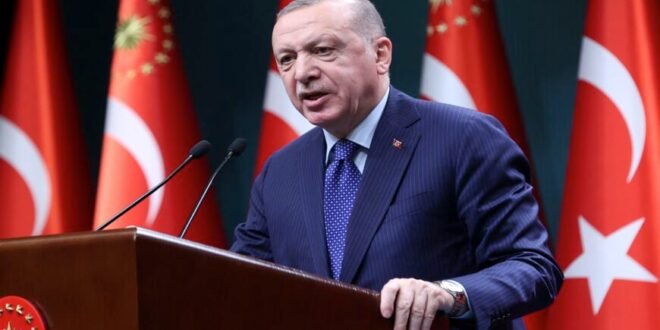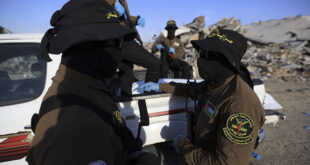A planned joint complex to house Turkey’s top military bodies is touted as a move to enhance the army’s coordination and interoperability, but political and economic motivations also lurk behind the project.
Turkey has launched the construction of the massive military complex, the Crescent and Star, named after the symbols of its national flag, to bring the Defense Ministry, the chief of General Staff, and the headquarters of the land, air and navy forces under a single roof, with the stated aim of enhancing coordination between military institutions and their operational effectiveness.
Dubbed “Turkey’s Pentagon,” the project will sprawl on an area of some 12.6 million square meters and have indoor spaces of 890,000 square meters to house up to 15,000 employees. A crescent-shaped structure in the middle of the complex will contain various conference halls, curving around a ceremonial ground of 23,000 square meters and facing a star-shaped structure to the south. The complex will be erected in Ankara’s suburb of Baglica, not far from the new, high-security headquarters to which the National Intelligence Organization (MIT) moved last year. The Defense Ministry, the chief of General Staff, and the headquarters of the land, air and navy forces are currently housed in separate buildings in Kizilay, the commercial heart of the Turkish capital, in close proximity to parliament and government buildings.
According to state-run media, “The design, originality, size and technological features [of the Crescent and Star complex] will make it one of the most modern and functional headquarters in the world.” The structure will “instill fear in enemies and give confidence to friends,” President Recep Tayyip Erdogan boasted at the groundbreaking ceremony Aug. 30.
The complex is expected to be inaugurated May 19, 2023, only about a month before critical presidential and parliamentary elections are scheduled to take place.
The plan to relocate military headquarters outside the city center dates back nearly a decade, although it was announced after the failed coup attempt in 2016. The project was first presented to Erdogan during a Supreme Military Council meeting in 2013 when he was prime minister and was taken up again at other high-level meetings in ensuing years. According to one presentation, the project “was launched in conjunction with the project to consolidate the Turkish armed forces’ scattered barracks structure and with the aim of eradicating the dense military outlook opposite parliament and at the center of the state; prevent the heavy traffic caused by personnel service vehicles; and strengthen and improve the sense of jointness between the forces’ commands, the Defense Ministry and the General Staff.” Additionally, it said, the project would help reduce staff by about 4,000 people.
After the coup attempt, the force commands were subordinated directly to the Defense Ministry rather than the General Staff, a move that seems to have accelerated plans to bring all top military bodies under one roof.
Speaking to journalists in 2019, Defense Minister Hulusi Akar said the prospective Crescent and Star complex will “rival the Pentagon,” adding Erdogan had given the go-ahead for the project.
Given that force commands and Defense Ministry buildings contain strategically important high-tech systems, the new complex is likely to yield lucrative profits for construction companies close to Erdogan, which are routinely awarded large public projects.
Details about the cost and financing of the complex have yet to be revealed, even though they carry added importance at a time when the country’s economy and public finances are in dire straits. Unofficial estimates put the cost at $600 million. The government has picked Ronesans Holding as a contractor, which became publicly known only when the chairman of the company, Erman IIicak, was invited to the stage during the groundbreaking ceremony.
Ronesans Holding is the builder of Erdogan’s gigantic presidential palace in Ankara, inaugurated in 2014, and his new summer mansion under construction in a secluded, picturesque cove on the Mediterranean coast, as well as the MIT’s new headquarters in Ankara and Istanbul. Standing out among other projects awarded to Ronesans are the sprawling medical complexes known as “city hospitals” in which the contractors receive billions of Turkish liras in rent and services as payments from the government.
Ilicak said at the ceremony the new complex would be completed in August 2023, but Erdogan insisted on an earlier date and extracted a pledge to have the complex ready in May that year. Some observers saw this as a sign that Erdogan wants to inaugurate the complex before the scheduled elections. Either way, it is an Erdogan classic to publicly put pressure on contractors to bring completion dates forward, even though this could affect the quality of work or lead to inauguration ceremonies before projects are fully completed, as has often happened in the past. Whether a single contractor could complete such a big project in such a short time remains open to question.
As for the essential purpose of the project, Erdogan said the prevailing security conditions required a better-coordinated defense establishment. In the context of Turkey’s military operations in Syria, Libya and Azerbaijan, the increased scope of the Turkish army’s duties and missions does make a well-equipped and unified headquarters a necessity. A joint location for the Defense Ministry, the General Staff and the forces’ commands could help ensure a more effective and faster coordination in addition to more efficient utilization of resources by saving significantly on time, energy and workforce.
Along with such upsides, however, the co-location of all defense units carries risks. A hostile act such as the 9/11 attack on the Pentagon, for instance, could make all institutions vulnerable at once.
That said, placing the General Staff and the force commands in a joint facility with the Defense Ministry is also an effort to strengthen civilian control over the military, in addition to enhancing interoperability among the land, air and naval forces. Still, major military capabilities such as combined force generation, interoperability and network-centric warfare do not necessarily require military leaders to be close physically in the 21st century. Whether the complex will boost the Turkish army’s command-control capabilities and operational effectiveness remains to be seen, but it will certainly give Erdogan an issue to boast about ahead of elections and yield nice profits for companies close to the government.
 Eurasia Press & News
Eurasia Press & News




